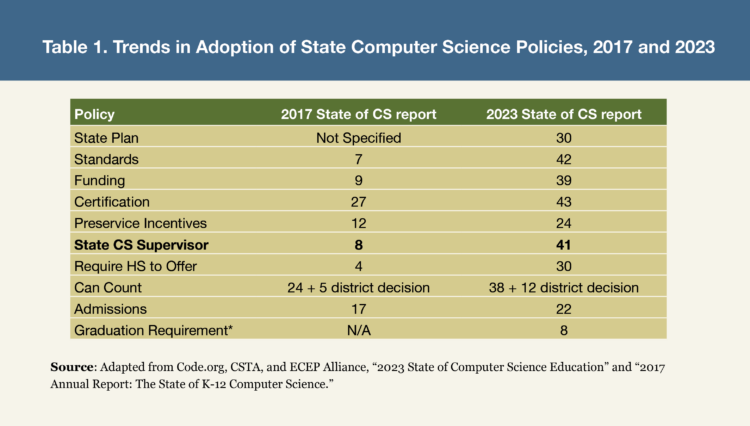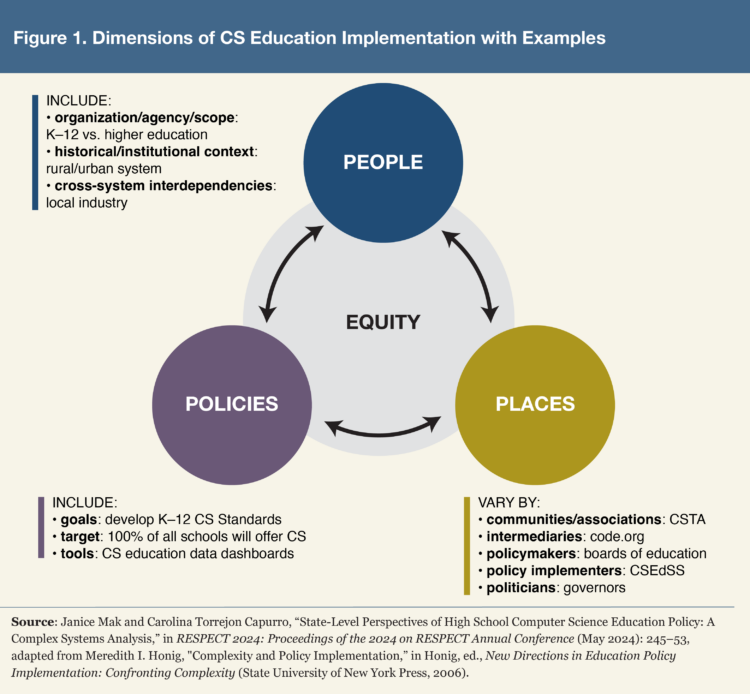Navigating Systemic Access to Computer Science Learning
Real advances to broaden participation in K-12 computing will come when state boards take a 360-degree view.


State policies to expand computer science (CS) education have popped up nearly everywhere since 2016. This acceleration speaks well to the collaborative work of state boards of education, intermediary and national organizations, state legislatures, and governors who championed those policies. It also speaks to the urgency of increasing all students’ skills in this critical content area. And yet when policies change at such a clip, the careful planning and coordination needed to ensure that more students truly gain access to opportunities to learn computer science often go by the way. State boards can be instrumental in mitigating the barriers to broadened participation in computing.
In an age with disruptive emerging technologies in which computing touches virtually every aspect of daily life, state leaders have acted to make CS an integral part of the K-12 experience. As of 2023, policies require teachers to possess a CS certification in 43 states, high schools to offer CS instruction in 30 states, and 30 states to adopt a state plan for CS education (table 1). Yet issues of access and opportunity will persist unless state leaders embrace a holistic, systemic view of the attendant implementation challenges.[1]

As a former member of the Arizona State Board of Education who was also a CS educator and advocate, I know how critical it is for state board members to consider the whole preK-12 system when engaging in policymaking. As a researcher, I employ a systems lens to analyzing the impact of CS education policies and their implementation. I recently received a National Science Foundation grant to do so, analyzing the ways in which policies are or are not broadening access to computing education across the nation. In the first year of this research, my team and I surveyed 31 state CS education supervisors. Our data revealed the impacts of new CS policies on access to funding, teacher training, resource development, teacher certification pathways, community outreach, and administrator support.
Take the move to make computer science a high school graduation requirement, for example. Nevada and South Carolina were the first to require it and include the funding to support it. Leaders in these states attest to the beneficial impact of this policy on gender parity in CS course enrollment.[2] Other states require all high schools to offer a CS course, although enrollment rates and the demographics of participating students vary depending on the local context. What happens when there are not enough trained and certified CS teachers or if prerequisite coursework stymies enrollment? What if there is no consensus on what CS content in a course is sufficient for credit? Exploring state leaders’ perspectives on CS education policy has helped me identify barriers to equitable CS education, as well as insights into what is working.
Barriers and Tensions
On the one hand, policy has accelerated adoption of CS education and opened up new avenues of funding and opportunities for teacher training. On the other hand, the struggle to find CS teachers is real: “We’re actually struggling to even just have teachers for required subjects, such as reading and writing . . . let alone to have a computer science teacher,” said one supervisor. Moreover, even if funding for training CS teachers is in place, it is critical to maintain a focus on equity to ensure that teachers across the state can participate in the training and have access to the resources required to implement the CS course successfully.
It is critical to maintain a focus on equity to ensure that teachers across the state can participate in the training and have access to the resources required to implement the CS course successfully.
Another area of tension that the state supervisors highlighted was the need to recognize CS education as part of a much larger system with its own interdependencies. “[F]ixing that teacher incentive and really valuing the teachers in a way is huge,” said one. “That’s certainly bigger than computer science [alone], but I think that’s got to be a priority.”
Another highlighted their work targeting support for local education agencies with financial difficulties, which the supervisor called “compounding factors of equity.” Variables such as teacher preparation, retention, recruitment, and schools’ financial stability affect how, when, and where CS education will be implemented.
Recent national survey data indicate that 61 percent of CS teachers see the importance of computing’s role in perpetuating biases related to racism, sexism, and other inequities in the classroom, while just over 50 percent feel that current CS content is culturally relevant and in alignment with student interests. Less than one-third of teachers report receiving ongoing instructional coaching in CS.[3] In addition, Gallup in 2020 found that Black students were still less likely than White students to have a dedicated CS class in the schools they attend. Boys tended to be more confident in their ability to learn CS than girls are and were more likely to consider CS learning a priority.[4]
Funding can create tensions in other ways: when newly funded priorities impede programs already under way, for example, or when requirements are unfunded altogether. One CS supervisor said their state’s legislature budgeted for CS education but restricted the funds’ use to high school CS. The restriction had the unintended effect of stalling work on the state’s plan for CS and cutting off CS education initiatives at the elementary level. “That particular part of the budget that I was using for K-5 got wiped away,” the supervisor said. “I’ve got no funds to do anything other than secondary.”
Questions State Boards Should Ask
When a significant policy is enacted, often within one legislative session, three dimensions of implementation kick in: policy, place, and people. It is critical to attend to how the three interact if a policy is to have the intended benefit and avoid unintended harms (figure 1). The figure lists several examples at each dimension that the CS supervisors raised with me. These examples underscore the importance of collaboration across all components to ensure efficacious policy execution.

Before adopting a policy, state board members ought to consider its implementation in a comprehensive way, integrating the perspectives of all stakeholders. For a graduation requirement policy, for example, board members can ask whether the state agency, teachers unions, teachers associations, education preparation programs at postsecondary institutions, and school leaders have collaborated. Engaging the CS education specialist at the respective state education agencies and teachers and leaders from local Computer Science Teachers Association chapters is particularly crucial when deliberating about any CS education policy.
State boards can also ask about plans to tackle critical challenges such as the shortage of qualified CS teachers and how teachers will be equipped with the content, skills, and pedagogy needed to teach CS in inclusive, equitable ways. If high schools must include CS courses, boards can ask if there is consensus regarding the content of a mandatory course and the criteria for determining which CS courses qualify for graduation credit.
Another question for state board members to ask concerns CS education pathways and gatekeeping courses. “One of the measures is algebra, and if … they haven’t passed algebra … [or] performed sufficiently, then [students are] blocked from certain pathways,” one CS supervisor said of implementation in their state. “That’s still under discussion. But that is a real area of concern.”
When planning for implementation, state board members and staff need to analyze the legislative language itself to see how accountability for equity is addressed. For instance, legislation may mandate that CS be offered at every high school as an elective rather than a core subject. This designation may result in high schools offering a course to fulfill the legislative intent but taking no further responsibility for CS education beyond offering that one course. Disparities may result. “We have 90-plus percent of high schools offering computer science,” said one supervisor. “[W]e still only have … 5-ish percent of students taking a computer science course in a given year.”
When planning for implementation, state board members and staff need to analyze the legislative language itself to see how accountability for equity is addressed.
For state board members, situations like these can prompt more questions:
- How will states determine which students are enrolling in an elective course?
- Will they require schools to provide disaggregated data on course participation?
- How can states ensure that all students have the opportunity and support to learn CS?
- If a proposal before the board would shift CS to a mandatory graduation requirement rather than an elective, what are the systemic implications?
Board members need to take a systems approach to ensure inclusive experiences for every student. As in so many other areas, well-rounded CS policies will build in mechanisms to support equitable implementation around teacher training, preservice teacher education, school and district leadership, curriculum, assessment, and ongoing training around culturally responsive and sustaining pedagogy in CS education, to list but a few considerations.
Key to ensuring broad participation in computing is asking students about their CS education experience: Are there opportunity gaps? What support do they receive in CS classes?
“Since we do have that graduation requirement, that has been awesome,” one CS supervisor said of state policy. “From the onset, if you look at the number of women or other underrepresented students, obviously the numbers are greater because we have that requirement.” But it is important to ensure that rural areas have access and to look at differences in student outcomes and teacher qualifications across the state, the supervisor said.
It is important to ensure that rural areas have access and to look at differences in student outcomes and teacher qualifications across the state.
Legislation that explicitly addresses certain marginalized populations but omits others will have an impact on access to CS education. “[W]e have an accessibility law … for students with disabilities mostly,” said a CS supervisor. “So it really affects computer science for blind students but also some [other] physical disabilities.… We also have a significant population of … multilingual learners, students who don’t speak English as their first language.…The only thing that we’re going to be held accountable for is the accessibility for students with disabilities.” This gap sparked new efforts within the state to extend CS education access to multilingual learners as well. When states take comprehensive measures, incorporating clear accountability measures supported by appropriate funding, they signal a commitment to accessible, equitable CS for every student.
Promising Practices
Staff. State CS supervisors highlighted some promising practices for ensuring broad access and participation. One is to engage school counselors in supporting equitable enrollment, said one supervisor, because they are instrumental in steering students toward selecting CS courses.
Data. Another promising practice is intentional data collection to illuminate areas of inequitable access and opportunity. Policies that are built in the absence of data can re-create new inequities and fail to address existing ones.[5] To ensure that data measure progress, comprehensive data collection plans must be developed—and not post hoc.[6]
State board members can support this practice by asking how state agency staff and districts will assess participation in K-12 CS education, how they will account for students’ intersectional identities and contexts, and how they will assess implementation at the elementary and middle school level. State boards can also ask how high school CS courses can benefit from the same robust data collection procedures that courses in career and technical education pathways and those funded by federal Perkins grants enjoy. For full transparency, data on enrollment and completion ought to be disaggregated, one CS supervisor suggested. Another noted that they have data reports that report the state of CS education at a point in time but no targets to work toward. Most important, state boards can ask how efforts to collect, analyze, and report on data will be supported. What funding and resources are available to do this work? Does the state education agency require additional staffing, for example?
For full transparency, data on enrollment and completion ought to be disaggregated.
Access before high school. As with all content areas, state boards’ vision for equitable CS education spans kindergarten through secondary school, including middle school. Thus another promising practice to broaden participation is to introduce computing early on, either in stand-alone courses or integrated within other subject areas.[7] Early introduction would support high school CS efforts by ensuring that every student gets to experience CS in engaging, interdisciplinary ways.
One state supervisor suggested this practice could be especially helpful for young girls and nonbinary students, who get the idea in their early schooling that computer science is not for them. “[W]e really need to have exposure to computer science, to all students, as early as possible to mitigate those issues,” the supervisor said. Researchers have suggested that CS learning as early as age 5 can benefit learning, self-esteem, and motivation.[8]
Collaboration. As with other policy areas, the barriers to broadening access to CS education do not exist in a vacuum but are affected by broader systemic inequities in priorities and resources. Distributed leadership can expand organizations’ capacity to address these inequities.[9] Inviting more people into the process is a key strategy to enable a school to manage change and approach policy implementation in a contextual way.
Secondary education faces many challenges, including murky education paths toward career aspirations and the skewed emphasis on core academic subjects that are tested for school and district accountability. These challenges affect computer science learning and ought to inform policy development to advance it. State boards operate within complex educational systems with competing demands for time and resources. Rather than emphasize policies based on compliance, state boards could explore collaborative ways to advance participatory policymaking that will truly broaden participation in computing.
Janice Mak was a member of the Arizona State Board of Education from 2016 to 2022 and currently has a joint appointment as the assistant director, curriculum & pedagogy, at the Learning Engineering Institute and is on the faculty at Mary Lou Fulton Teachers College at Arizona State University. She would like to thank the CS education state supervisors who participated in this research and her research assistant, Carolina Torrejon-Capurro, for her collaboration. The research in this article was made possible by funding from NSF grant #2239481.
Notes
[1] Code.org, CSTA, and ECEP Alliance, “2023 State of Computer Science Education” (2023).
[2] Other states have considered legislation to institute similar policies.
[3] Sonia Koshy et al., “The Computer Science Teacher Landscape: Results of a Nationwide Teacher Survey” (CSTA and Kapor Center, May 2021).
[4] Gallup, “Current Perspectives and Continuing Challenges in Computer Science Education in U.S. K-12 Schools” (2020).
[5] Anne Leftwich et al., “The Landscape of Broadening Participation in Computing, Using State and National Datasets to Advocate for Equity in Computer Science Education,” Proceedings of the 51st ACM Technical Symposium on Computer Science Education (February 26, 2020): 1403–03, https://doi.org/10.1145/3328778.3372530.
[6] Sarah Dunton et al., “Determining Metrics for Broadening Participation in Computing: Connecting Data to Multi-State Computer Science Education Policy Efforts,” Policy Futures in Education (January 28, 2022), https://doi.org/10.1177/14782103211064443.
[7] Aman Yadaz, Hai Hong, and Chris Stephenson, “Computational Thinking for All: Pedagogical Approaches to Embedding 21st Century Problem Solving in K-12 Classrooms,” TechTrends 60 (2016): 565–68.
[8] Mary Webb et al., “Computer Science in K-12 School Curricula of the 21st Century: Why, What, and When?” Education and Information Technologies 22 (2017), https://doi.org/10.1007/s10639-016-9493-x.
[9] James P. Spillane, Richard Halverson, and John B. Diamond, “Investigating School Leadership Practice: A Distributed Perspective,” Educational Researcher 30, no. 3 (2001): 23–28.
Also In this Issue
State Education Policy and the New Artificial Intelligence
By Glenn M. Kleiman and H. Alix GallagherThe technology is new, but the challenges are familiar.
Opportunities and Challenges: Insights from North Carolina’s AI Guidelines
By Vera CuberoEarly guidance helps all schools seize the technology’s potential and mitigate the risks.
Connecting the National Educational Technology Plan to State Policy: A Roadmap for State Boards
By Julia FallonState leaders can use the plan to gauge whether their policies are expanding technology access, teachers’ capacity, and the learning experience.
Navigating Systemic Access to Computer Science Learning
By Janice MakReal advances to broaden participation in K-12 computing will come when state boards take a 360-degree view.
Ensuring Student Data Privacy through Better Governance
By Paige KowalskiState boards should champion laws to stand up robust cross-agency boards and advocate for best practice.
Advancing Policy to Foster K-12 Media Literacy
By Samia Alkam and Daniela DiGiacomoSome state leaders are moving to provide students with what they need to better navigate the digital world. More should.
Shielding Student Data: The Critical Role of State Boards in K-12 Cybersecurity
By Reg LeichtyA coordinated push is needed to ward off increased threats and mounting costs.










 i
i
 i
i